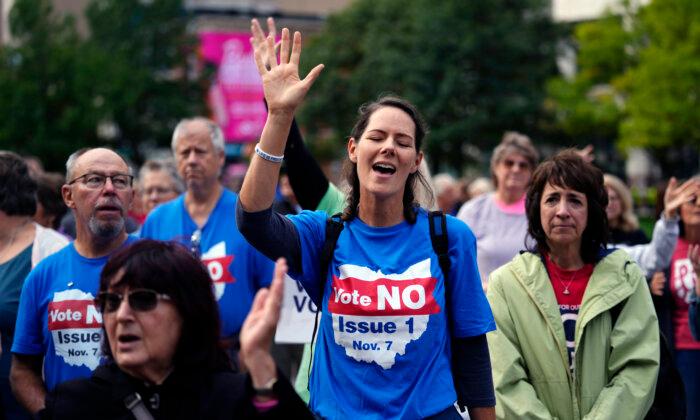Ohioans started heading to the polls on Oct. 11 as early voting began in an election that will decide whether abortion is enshrined as a right in the state’s constitution.
Issue 1 is expected to drive higher-than-usual turnout in the state’s off-year election as voters both for and against the controversial ballot measure attend the polls.
If passed, the proposed constitutional amendment would establish that every individual has “a right to make and carry out one’s own reproductive decisions, including but not limited to decisions on contraception, fertility treatment, continuing one’s own pregnancy, miscarriage care, and abortion.”
The text of the measure also states that abortion may be prohibited “after fetal viability.” However, it adds that “in no case” will the procedure be prohibited if the patient’s treating physician says it’s necessary to protect the patient’s life or health.
For those who support Issue 1, that caveat is a compromise with those who oppose late-term abortions.
However, the amendment’s detractors say that it would allow a patient’s doctor to determine whether an abortion is necessary, creating an easy loophole.
Last month, the Ohio Supreme Court upheld the board’s replacement of the word “fetus” with “unborn child,” rejecting the petitioners’ argument that the phrase introduced an “ethical judgment” to persuade voters.
However, the court agreed with petitioners that the board’s change of “the state” to “citizens of the state” to refer to the entity barred from interfering with the outlined right was misleading.

Abortion has remained a crucial issue for voters around the country since the U.S. Supreme Court controversially overturned Roe v. Wade last year.
The ruling erased decades of judicial precedent upholding abortion as a constitutional right and returned the matter to the states to decide.
In Ohio, the move opened the door for the temporary revival of a six-week abortion limit that was passed in 2019 only to be blocked a few months later by a federal judge.
The state moved to dissolve that injunction after the High Court’s decision, and the law took effect for a few months before it was challenged and blocked again. The state’s Supreme Court is currently weighing whether the law should be reinstated.
Ohioans United for Reproductive Rights has emphasized the possibility of the law’s resurrection as a means of driving voters to the polls in support of Issue 1.
“For more than 80 days, Ohioans were subjected to devastating trauma due to Ohio’s extreme abortion ban,” the group said in a Sept. 27 statement.
A ‘Life-or-Death Matter’
Those who oppose Issue 1 have expressed concern over the measure’s broad language, holding that it could allow minors to obtain abortions or gender-altering procedures without parental knowledge or consent.“Not only that but the proposed amendment outlaws any protections for women and unborn children, even through the ninth month of pregnancy,” she added.
“This amendment is way too extreme for Ohio.”
Last week, a group of more than 100 black faith and community leaders in the state agreed, calling on all Ohio voters “who believe in the inherent value of every person” to reject Issue 1.
“This is not a party-line vote, nor is Issue 1 a Republican or Democrat issue,” they added. “This is a moral issue, and for the black community in particular, it is a life-or-death matter.”
Noting this, the faith leaders charged that the agenda behind Issue 1 and the overall abortion industry is “driven by racism and greed.”
“Our faith sustains us every day, and it must now spur us on to defeat this amendment and save countless black lives in doing so,” they wrote.
“Together, we must send a message to the abortion industry by stopping Issue 1. We must end the targeting of black babies and instead promote a culture of life.”
Election Day is Nov. 7.
Early, in-person voting in Ohio will continue on weekdays through Nov. 3 and through the following weekend, Nov. 4 and Nov. 5.







